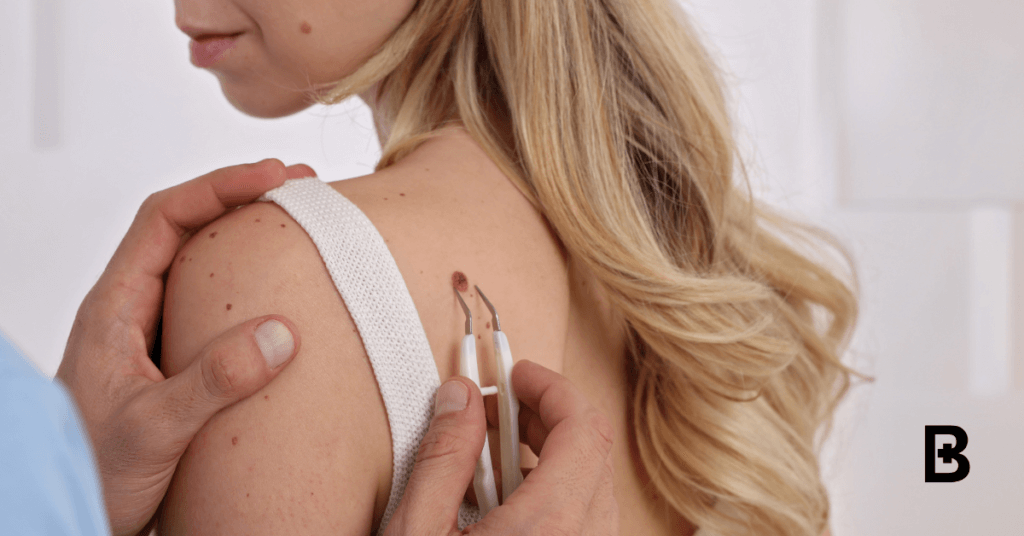Understanding and differentiating these from other skin conditions is crucial. At Bodyvie, we offer private anal skin tag removal, ensuring our patients are informed, comfortable, and under the care of experienced doctors. Never forget: only a qualified professional’s expertise ensures effective treatment, minimises potential complications and provides peace of mind.
More Than Meets the Eye
When you first spot an anal skin tag, its soft, flap-like appearance might make you a bit nervous. While the colour usually mirrors the surrounding skin, it can sometimes be a shade or two darker. They predominantly form around the anus, but their presence occasionally extends to adjacent areas.
On closer observation, one can notice that these growths differ from other skin protrusions. They don’t usually grow in size over time, unlike warts or moles that may expand or evolve in shape. Their primary characteristic is that they remain consistent in their appearance, hanging gently from a thin stalk or base.
They’re typically painless; however, their location makes them prone to irritation from clothing, faecal matter, or regular activities like walking or sitting. When irritated, they might turn red or feel sore. That irritation may lead to significant itchiness, known as Pruritis Ani. It’s also possible for a skin tag’s stalk to twist, cutting off its blood supply and leading to sudden discomfort.
Origins and Causes
Anal skin tag formation stems from a myriad of factors, such as the following:
- Friction: This remains one of the most common causes. Constant rubbing of clothing, or even skin against skin, especially in areas with skin folds, can develop these tags.
- Medical History: A bout of haemorrhoids or certain surgeries might stretch the skin slightly. Once the swelling subsides, the skin doesn’t always return to its original state, forming skin tags.
- Pregnancy and Childbirth: Skin tags can form as a postpartum symptom due to increased pressure and stretching in the anal area during childbirth.
- Ageing: Over time, our skin loses its elasticity. This natural sagging can, in some instances, manifest as skin tags.
- Other Factors: Increased body weight or obesity can accentuate skin folds, thereby increasing friction and, subsequently, the likelihood of skin tags.
Separating Anal Skin Tags from Similar Conditions
Many are often left perplexed trying to differentiate between anal skin tags and other look-alike conditions, so here’s a breakdown to make it a little easier for you:
- Haemorrhoids: These swollen blood vessels might cause similar discomfort as skin tags. However, they’re fundamentally different, often more painful and occasionally bleeding.
- Warts: Resulting from viral infections, warts possess a texture that’s noticeably rougher than the silky feel of skin tags.
- Moles: Moles are generally more uniform, having a more rounded shape, in contrast to the floppy, irregular contour of skin tags.
To err is human, so always seek a professional opinion if ever in doubt. At Bodyvie, our doctors are always ready to provide definitive diagnoses and help you navigate your concerns.
Debunking Myths: The Fact Behind the Fiction
Misconceptions around anal skin tags abound, perpetuating fear and uncertainty. Here’s what you should know:
- Cancer Link? Anal skin tags are non-cancerous. They don’t metamorphose into malignancies.
- A Universal Misdiagnosis: Not all growths in the anal region are skin tags. It’s crucial to differentiate for proper treatment.
- DIY Removal: Embarking on home removal is fraught with risks, including infections. It’s always safer to consult a medical expert before making any decisions.
With all of these, we can clearly see that good knowledge becomes our shield against these and other myths, allowing us to navigate our concerns with clarity and fact-based assurance.
Options for Addressing and Treating Skin Tags
As previously mentioned, skin tags don’t necessarily require medical intervention. However, for those choosing removal due to discomfort or aesthetics, Bodyvie offers a minor surgical procedure for anal skin tag removal. Surgical removal is a quick and effective method that involves cutting off the tag. Our experienced doctors administer a local anaesthetic for patient comfort, with the treatment typically taking about 30 minutes.
Post-procedure care is crucial for promoting healing and preventing complications. Typically, this involves ensuring the treated area remains clean and free from unnecessary friction. To reduce the chances of skin tags reappearing, it’s really important to maintain optimal hygiene and address any underlying causes that might have contributed to their initial formation.
Knowledge as the Path to Peace of Mind
Anal skin tags, while commonplace, can be the cause of undue concern for the uninformed. Understanding their benign nature, recognising their characteristics, and knowing when to seek expert intervention can equip anyone to handle the situation with poise and confidence. In the realm of personal health and well-being, awareness remains our most potent ally.
















I had some misconceptions about anal skin tags, but this article clarified things. It’s a relief to know they are non-cancerous and that they won’t turn into something more serious.
The emphasis on lifestyle and dietary changes, which can make a significant difference in preventing and managing piles, is particularly insightful. It’s a reminder that small adjustments to our daily routines can lead to big improvements in our overall health. Aloe vera gel may provide relief from itching and inflammation around your anus. Wear cotton clothing instead of tight clothing to reduce irritation caused by trapped irritants in your anus. Goat milk may help treat piles. Packed with vitamin A and anti-inflammatory compounds, goat milk can reduce swelling and itching as well as prevent future blood clot formation in your anus. In addition, analgesics may provide pain relief.